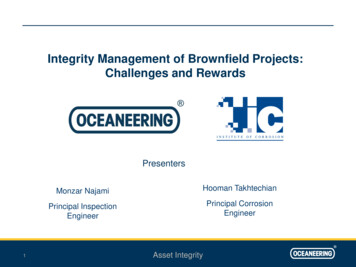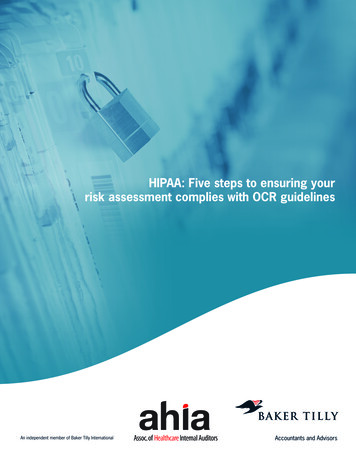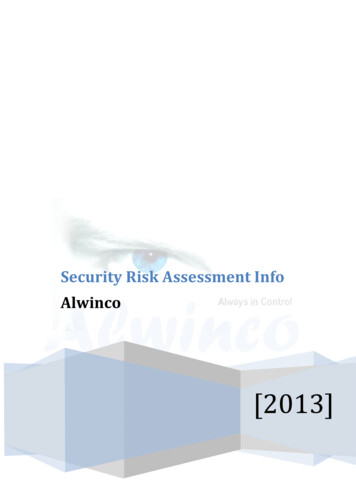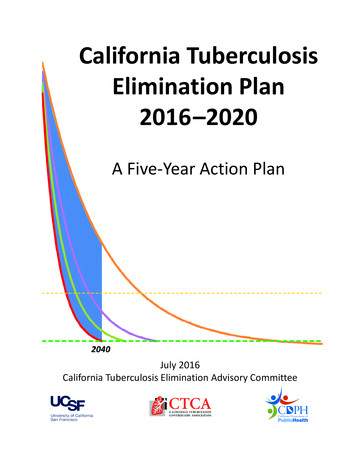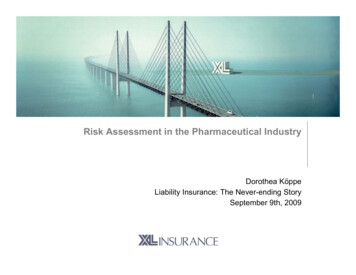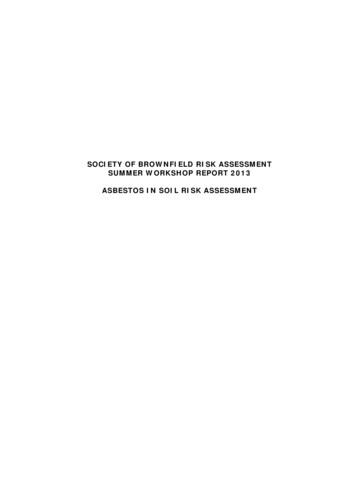
Transcription
SOCIETY OF BROWNFIELD RISK ASSESSMENTSUMMER WORKSHOP REPORT 2013ASBESTOS IN SOIL RISK ASSESSMENT
PUBLICATIONThis report summarises the key technical issues relevant to the risk assessment of asbestos insoil as presented and discussed at a SoBRA (Society of Brownfield Risk Assessment) workshopin June 2013.Whilst every effort has been made to ensure the report is an accurate account of the workshopproceedings, neither SoBRA nor the authors of the report accept any liability whatsoever for anyloss or damage arising in any way from its use or interpretation, or from reliance on any viewscontained herein.All rights are reserved. No part of this publication may be reproduced, stored in a retrievalsystem or transmitted in any form or by any means without the written permission of thecopyright holder.Copyright Society of Brownfield Risk Assessment 2015ISBN number: 978-0-9568241-6-5Published by the Society of Brownfield Risk AssessmentSoBRA Summer Workshop Report – Asbestos in SoilPage i
PREFACEThe Society of Brownfield Risk Assessment (SoBRA) was established in December 2009with the principal aim of promoting technical excellence in land contamination riskassessment in the United Kingdom (UK).As part of achieving this aim, SoBRA have undertaken to host regular conferences andworkshops on technical subjects of interest to UK risk assessors.SoBRA’s first Summer Workshop was held in June 2010 in York where the humanhealth risk assessment of polycyclic aromatic hydrocarbons in soil was considered.SoBRA’s second Summer Workshop was held in June 2011 at the Mechanics Institute inManchester. It addressed the assessment of the risks associated with leadcontamination in soil.SoBRA’s third Summer Workshop was held in June 2012 at Armada House in Bristol. Itaddressed the assessment of risks associated with petroleum hydrocarbons ingroundwater.The current report describes the proceedings of SoBRA’s fourth Summer Workshop,which considered the risk assessment of asbestos in soil. The event was held at thePriory Rooms in Birmingham on 27th June 2013. Rather than the usual thematic formatestablished by previous events, the specific aim of the event was to support the JointIndustry Working Group (JIWG) risk assessment chapter. Therefore, the event focussedon the risk assessment aspects of asbestos throughout the CLR11 process. The threekey themes were:1. site investigation support;2. exposure scenario – remediation and cross boundary issues; and3. exposure scenario – existing/future land users decision algorithm.Delegates received presentations from expert speakers on these three topics andparticipated in separate afternoon workshops on the same themes. During the morningproceedings, delegates also heard a presentation from Public Health England on thechallenges of toxicology, and a lawyer’s perspective on the application of the Control ofAsbestos Regulations 2012 (CAR 2012) with respect to soil.Eighty nine delegates, including expert speakers and SoBRA Executive Committeemembers, attended the 2013 Summer Workshop. Feedback provided by delegates afterthe event was extremely positive with more than 90% of responding delegates ratingthe event as “excellent” or “good”, with similar high scores awarded to the speakersand more than 80% of responding delegates also highly rating the individual afternoonworkshops. Overall, therefore, the 2013 Summer Workshop consolidated SoBRA’scommitment to hosting high quality and stimulating meetings on technical topics ofrelevance to its members.This report fulfils an undertaking given by SoBRA to produce a formal record of theproceedings of the workshop. It summarises the expert presentations given on the day,records current views on the main technical issues within each subject area anddescribes the challenges identified by risk assessors in dealing appropriately withasbestos in soil.SoBRA Summer Workshop Report – Asbestos in SoilPage ii
ACKNOWLEDGEMENTSSoBRA wishes to thank the following individuals for their considerable assistance in thesuccessful delivery of the SOBRA 2013 Summer Workshop and associated report.David HallGolder AssociatesWorkshop ChairMike HigginsHydrockSpeaker and workshop 2facilitatorSimon ColeURSSpeaker and workshop 3facilitatorGeorge KowalczykPublic Health EnglandSpeakerSeamus LeFroy BrooksLBH Wembley Geotechnical& EnvironmentalSpeakerJohn ParkerRSKSpeakerMartin StearWorkplace EnvironmentSolutions LtdSpeakerAlan JonesInstitute of OccupationalMedicineWorkshop 1 facilitatorSimon FirthFirth ConsultantsWorkshop 4 facilitatorLindsay PepperellERMWorkshop 1 rapporteurGareth WillsParsons BrinckerhoffWorkshop 2 rapporteurSteve ForsterIEG Technologies UKLimitedWorkshop 3 rapporteurLucy ThomasRSKEditorsNaomi EarlIndependent ConsultantSpecial thanks are due to Ed Stutt (WCA Environment) and Lucy Thomas (RSK) ofSoBRA’s Executive Committee and Simon Cole (URS) for the smooth organisation andrunning of the event. Also, to Hannah White (Atkins and SoBRA’s treasurer) who lookedafter financial matters, Chris Taylor (Brent Council and SoBRA’s secretary) whoorganised bookings and finally to our Chair for the event, David Hall (Golder Associatesand SoBRA’s Executive Committee Chair) for providing a thought provokingintroduction to the event.Finally, SoBRA wishes to acknowledge the contribution to the overall success of theevent made by individual workshop delegates for attending and enthusiasticallyparticipating in the day’s proceedings.Workshop delegates are listed in Appendix 1 to this report.SoBRA Summer Workshop Report – Asbestos in SoilPage iii
CONTENTS1 INTRODUCTION11.1Background11.2Objective and aims21.3Structure of the report22 EXPERT PRESENTATIONS42.1Site investigation and analysis of asbestos2.2Laboratory analysis2.3Legal aspects / case law and how this might influence risk assessment112.4Remediation and re-use122.5Asbestos: review of toxicology & options for human health riskassessment132.6Approaches to exposure assessment3 SITE INVESTIGATION dance published subsequent to the workshop283.4Key issues283.5Conclusions313.6Recommendations314 EXPOSURE SCENARIO – REMEDIATION, RE-USE & CROSS BOUNDARY ISSUES324.1Introduction4.2Objective324.3Key issues324.4Conclusions334.5Recommendations335 EXPOSURE SCENARIO – EXISTING / FUTURE LAND USERS DECISION ALGORITHM –GROUP 132345.1Introduction345.2Objective345.3Key Issues345.4Conclusions365.5Recommendations366 EXPOSURE SCENARIO – EXISTING / FUTURE LAND USERS DECISION ALGORITHM –GROUP 2376.1Introduction376.2Objective376.3Key issues376.4Conclusions396.5Recommendations397 CONCLUDING REMARKS407.1Key Issues and Recommendations407.2Delivering the Recommendations418 REFERENCES42SoBRA Summer Workshop Report – Asbestos in SoilPage iv
TablesTable 1: Physical fibre properties observable under a stereoscopeTable 2: Summary of asbestos properties recorded using PLMTable 3: Fibre confusion and remediesTable 4: Airborne levels of asbestosTable 5: Chrysotile and mesothelioma; 1 in 100,000 excess lifetime cancerTable 6: Hodgson and Darnton risk estimates – mesothelioma risk per 100,000Table 7: Age adjustment factors for mesothelioma risk dependent on the age at which exposurecommences (Howie, 2012)FiguresFigure 1:Figure 2:Figure 3:Figure 4:Figure 5:Figure 6:IAQM flowchart of steps to perform a dust assessmentAddison et al. dataAddison et al. data split for soil typeAddison et al. data split for fibre typeAddison et al. data airborne dust and fibre correlationComparison of Addison et al. and RIVM dataAppendicesAppendix 1: Workshop GroupsAppendix 2: AbbreviationsSoBRA Summer Workshop Report – Asbestos in SoilPage v
1INTRODUCTION1.1BackgroundAsbestos is a naturally occurring mineral. It was recognised for use within thebuilding industry owing to its flame retardant and insulating properties. It wasimported and used extensively in the building industry primarily between the latenineteenth century and the late twentieth century but can be present in buildingsconstructed up to and including 1999 when it was prohibited. The asbestos wasused in different forms: cement, spray coatings, textured coatings, lagging,bitumen and vinyl products and board. Uses included insulation, fire protection tosteel work and in ducts, wall panels and partitions, rope, textiles, school noticeboards, utility pipes, ceilings as tiles and as decorative plaster, roofing as cementand felt, gutters, water tanks, sinks, toilets and vinyl floor tiles. Consequently,asbestos is present in UK buildings and, as a result of redevelopment activitiesand below ground services, in the soil.There are three main types of asbestos: crocidolite, amosite and chrysotile. Theseare often referred to as blue, brown and white respectively. There are a furtherthree rarer types of asbestos: tremolite, actinolite and anthophyllite. There aretwo types of asbestos fibres: serpentine and amphiboles. Uncertainty existsregarding the potency of the different fibres, although it is commonly reportedthat amphibole fibres have a greater potency than serpentine fibres. Amosite andcrocidolite are examples of amphibole fibres whilst chrysotile is the onlyserpentine fibre.As a rule of thumb, lagging, insulating board and sprayed coatings are more likelyto contain crocidolite and amosite asbestos. Insulation and lagging are most likelyto give off fibres owing to the absence of a bonding material. Furthermore, theseproducts can contain up to 85% asbestos. Hence, these forms of asbestosgenerally pose the greatest risk. By comparison, asbestos cement typicallycontains 10-15% asbestos and this is bound into the cement. Hence, fibres areonly released if the cement is broken.Exposure to asbestos fibres can lead to carcinogenic and non-carcinogenic healtheffects although these usually do not occur until 15 and 60 years later (HSE, 2012(a)). Thus, challenges are faced with respect to exposure, which is cumulativeover a lifetime. Therefore, the age at which a person is exposed becomes animportant factor in the risk assessment. Another challenge is how the potency ofthe different asbestos types is incorporated into a risk assessment.The Control of Asbestos Regulations, often referred to as CAR 2012, legislationcame into force in April 2012. Under these regulations every employer has a dutyto prevent or, where this is not reasonably practicable, to reduce spread andexposure of people to asbestos. Regulation 5 requires an employer to undertake arisk assessment before demolition, maintenance or any other work that mightexpose employees to asbestos at the premises. The Association of Geotechnicaland Geoenvironmental Specialists (AGS, 2013) notes that CAR 2012 applies toland included in the premises rather than just the buildings. Guidance to supportCAR 2012 with respect to asbestos in soil, however, was not published. Thus,uncertainty and inconsistency exists in the industry in terms of how to deal withasbestos in soil under CAR 2012.At the time of the workshop, a CIRIA project was underway to improve theperformance of practitioners and other professionals when undertaking riskassessments on sites that could be contaminated by asbestos. This project wassubsequently published on 26th March 2014 (CIRIA, 2014).SoBRA Summer Workshop Report – Asbestos in SoilPage 1
Owing to inconsistent application of CAR 2012 regulations and the associatedcommercial and compliance risks, the JIWG was set up. JIWG comprises industryand government bodies, chaired by the Environmental Industries Commission(EIC) with Contaminated Land: Applications in Real Environments (CL:AIRE)acting as secretariat. The group aims to provide practical guidance in the form ofa Code of Practice. This will be based on clear and consistent regulatoryenforcement positions which will reduce uncertainty and the consequentcommercial and compliance risks.JIWG has six key issue focus groups: investigation and monitoring; laboratory analysis; waste management; CAR 2012 / Environmental Permitting Regulations (EPR) 2010; asbestos work categories; and human health risk assessment.SoBRA is contributing to the human health risk assessment chapter. Hence, theSummer Workshop and asbestos sub-group was established to supportdevelopment of this chapter.1.2Objective and aimsThe objective of SoBRA’s summer 2013 workshop was to inform the human healthrisk assessment chapter of the JIWG Code of Practice for asbestos in soils.The aims of the workshop were to: provide high quality speakers who could outline the challenges faced fortheir topic area that affect the risk assessment process, including siteinvestigation, laboratory analysis, the legal framework, toxicology,exposure modelling and remediation; and break out into workshop groups to discuss issues pertaining to a topic areain more detail and identify how such issues might be resolved. The threetopic areas were: site aboratory exposure scenarios that might be used to evaluate remediation, reuse and cross boundary issues; and algorithms for existing/future land user exposure scenario for whichthere were two parallel groups.Note, although toxicology is a key aspect of the risk assessment, it wasconsidered that insufficient people with adequate toxicological knowledge wouldbe attending the event and therefore a workshop on this topic would beimpracticable.1.3Structure of the reportA specific goal of the workshop organisers was to produce a formal workshopoutput that summarised the proceedings, consolidated ideas and maderecommendations on the work required to support risk assessment efforts in thefuture. Following this introduction, Section 2 of the report sets the scene for theworkshop proceedings by providing accounts of the challenges faced by industrySoBRA Summer Workshop Report – Asbestos in SoilPage 2
relating to the risk assessment of asbestos in soil. Sections 3 to 6 provide afactual account of the workshop discussion group outputs. The exposure scenarioexisting / future land users topic was discussed by two groups with the intentionthat the proposed methods by both groups could be compared to help inform thework of the JIWG. Therefore there are two sections (Section 5 and Section 6) todescribe the discussion outputs of the two groups.Subsequent to the workshop, the SoBRA asbestos sub-group developed the toolsused for exposure scenarios of existing and future land users. This work ispresented in Section 7. Concluding remarks, including areas for further work toinform scientifically robust risk-based decision making, are provided in Section 8.Reference documents used to support presentations and workshop discussions areshown as footnotes to the text, and are collated as a complete list in Section 9 ofthe report.Appendix 1 gives details of the workshop groups including names of individualparticipants. Appendix 2 sets out a list of abbreviations used in the report.SoBRA Summer Workshop Report – Asbestos in SoilPage 3
2EXPERT PRESENTATIONSSix speakers kindly gave their time to prepare and give presentations. Thepresentations are summarised in the following sub-sections and comprised:2.1 site investigation and analysis of asbestos; legal aspects/case law and how this might influence risk assessment; remediation and re-use; asbestos: reviewassessment; and approaches to exposure ite investigation and analysis of asbestosThe presentation outlined how the AGS sub-group on asbestos in soil has usedthe CAR 2012 to give practical advice on protecting site investigation andgeotechnical laboratory staff from asbestos in soil.By means of introduction, it was recognised that investigation is usuallyundertaken to determine geotechnical properties of the ground and/or toascertain its suitability for use. Investigation is rarely undertaken purely todetermine whether asbestos is present within soil. Subsequent to CAR 2012, it isnecessary to assess the potential for people to be exposed to asbestos includingat the investigation stage. Hence, AGS developed interim guidance to enable AGSmembers to be aware of their responsibilities and to offer practical measures tocomply with CAR 2012.The presentation highlighted that the first risk assessment must be done beforeanyone goes to site which poses challenges since although each Industry Profilerefers to asbestos as a potential contaminant, its presence, form and quantity areuncertain. Key questions to be considered when undertaking a risk assessmentare: Is there a risk of asbestos being present? Is there a risk of asbestos fibre release? and Is there a risk of the fibre release exceeding the control limit?The presentation noted that notification to the Health and Safety Executive (HSE)was not required where: the exposure of employees to asbestos is sporadic and of low intensity; it is clear from the risk assessment that the exposure of any employee toasbestos will not exceed the control limit; and the work involves the collection and analysis of samples to ascertainwhether a specific material contains asbestos.The AGS sub-group considered whether there were any ‘safe’ levels for asbestosin soil. Given it is the inhalation of fibres that cause disease, the sub-groupconsidered information would be needed to ascertain whether there is arelationship between: the amount of fibres in the air and the risk of disease; and the concentration of fibres in the air and the concentration of fibres in thesoil.SoBRA Summer Workshop Report – Asbestos in SoilPage 4
The sub-group also considered that in order for indirect exposure to occuroutdoors, free fibres must be present at the ground surface, and the fibres mustbecome airborne. Fibres may become airborne through dry and windy conditionsand/or vehicle and/or machinery movements.For indirect exposure to occur indoors, wet and muddy conditions within the soilcontaining asbestos fibres would be required to permit mud being trodden back tothe property. Two key parameters that affect fibres becoming airborne and thusexposure to people are: drying and airflow.Asbestos poses a risk when fibres become airborne and are inhaled. The majorityof people working in site investigation are not air specialists. Hence, it isnecessary for our industry to engage with other specialist skill sets. This isrecognised by the JIWG of which AGS is part. Further details of JIWG are providedin Section 1.1.The presentation also documented the following data sources that affect ourjudgement on asbestos in soil. These include the importance of the:2.2 Supreme Court mesothelioma ruling (Sienkiewicz v Greif UK Ltd, Willmorev Knowsley Metropolitan Borough Council (2011) 1; Environment Agency (EA) position on waste as laid out in WM2(Environment Agency 2013); HSE position on guidance 2; Enterprise and Regulatory Reform Act 2013, which prevents civil claimsbeing made in respect of breaches of duties under health and safetylegislation; and public awareness / perception.Laboratory analysisThe second half of the first presentation focussed on laboratory techniques forasbestos identification. The presentation included:12 methods for bulk analysis of suspected asbestos- containing materials(ACM) including details of the equipment used; detection limits and quality control (QC) checks undertaken; uncertainty; and fibre in air analysis.The Supreme Court ruling upheld the original High Court ruling (Willmore v Knowsley MetropolitanBorough Council, (2009)) that made the decision that no burden of proof was required beyondshowing minimal or “de minimis” exposure and a foreseeable health hazard, even though thedefendants could show relatively minor or infrequent (“i.e. fleeting”) exposure.At the time of publication, there is still no published HSE guidance that deals with asbestos in soils.It is expected that a revised draft version of HSG248, incorporating guidance on sampling andanalysis of soils for the presence of asbestos will be available for consultation in 2015.SoBRA Summer Workshop Report – Asbestos in SoilPage 5
2.2.1 Bulk analysisThere are several stages to bulk analysis comprising:3 initial examination – sample examination by eye to describe the materialand product type, see whether visible fibres are present and ascertainlayers within heterogeneous products; stereoscopic examination – use of a low powered scope (X10-X30) todetect fibres, ascertain fibre colour, texture and tensile strength, lustre,tenacity and elasticity. These properties help identify asbestos since allfibres are flexible, all except chrysotile are elastic and, with the exceptionof chrysotile and crocidolite, all asbestos has a vitreous lustre. Chrysotilehas a silky lustre and crocidolite a metallic lustre. Details of theseproperties for different asbestos products are recorded in Table 1; sample treatment – reagents are used to remove biological and chemicalbinding agents in order to release fibres from the sample. Heating/burningcan be used but it can also affect the fibre integrity; polarised light microscopy (PLM) preparation – slides are prepared byplacing a drop of appropriate refractive index liquid onto the slide,suspected asbestos fibre is then placed on the slide so it is immersed inthe drop and a cover slip is placed over the top. The slide of suspectedmaterial can then be analysed and compared to accepted standards issuedby the HSE within HSG248 (“the Analysts Guide”) (2006); only thosematching these standards may be declared as positive for the asbestostype identified. If suspected asbestos fibres are not discovered during thestereoscopic examination, then two slides of the sample material will stillneed to be analysed using PLM before the sample may be declared asnegative for the presence of asbestos; PLM analysis – using polarised light, fibres are examined for the followingproperties: fibre morphology, colour and pleochroism colours, extinction,signs of elongation and birefringence 3. Laboratory analysts use theseproperties to positively identify individual types(s) of asbestos within thesample. Table 2 records these properties for the different types ofasbestos; and dispersion staining – colours and phase contrast are used together withknown extinction and elongation properties of the different asbestos typesto identify the asbestos type with utmost confidence.Birefringence is defined by the Collins Concise English Dictionary as the splitting of a ray ofunpolarized light into two unequally refracted rays polarized in mutually perpendicular planes.SoBRA Summer Workshop Report – Asbestos in SoilPage 6
Table 1: Physical fibre properties observable under a stereoscope (HSG248, ess/whiteTexture &appearanceSoft, curlybundles, flexiblefibres, cling totweezersHighStraight fibres,bundles,relatively flexiblefibresMediumSmall fibres, breakseasily, loose can bevery fine with lowaspect trengthSuspectedasbestos typeRequiredrefractiveindex liquidWhite – palegreenStraightfibresWhite brownStraightfibres,needle- likeDeep blueLowHighStraight brushlike fibres,barbs whenpulled 51.6401.6701.700Table 2: Summary of asbestos properties recorded using PLM (HSG248, 2006)Asbestos typeRefractive Pleochroismfibre reenNoneBlueLowComplete orundulose withcurved plete;parallel orsmall angleModerateComplete;parallel orsmall e;parallelSoBRA Summer Workshop Report – Asbestos in SoilPage 7
45Asbestos typeSign ofelongationChrysotileUsually positive(length slow)AnthophyllitePositive (lengthslow)TremolitePositive (lengthslow)ActinolitePositive (lengthslow)AmositePositive ispersionstaining fibreparallelPhase contrastFibreperpendicular,fibre colourPhase contrast,fibre haloPhase contrast –fibre parallel,fibre colourPhase contrast –fibre parallel,fibre-fibre haloRefractive indexrange-na lynegative(length owBluePale rangeOrangeRed-brownPale blueDark greyDark greyDark -1.6751.680-1.692Refractive indexrange-ny -1.6941.683-1.700Lower rangeUpper rangeSoBRA Summer Workshop Report – Asbestos in SoilPage 8
2.2.2 Detection limits and quality controlAs with any laboratory technique, quality control is paramount. A single fibre canbe found within a few mg of material. For a fibre measuring 100µm x 2µm, thisimplies a detection limit of 1ppm. Hence, cleanliness of all tools and work area isessential to minimise cross contamination.Analysts undertaking bulk asbestos identification adhere to quality controlschemes. Monthly, a number of samples are analysed by another analyst, withexternal quality control taking place quarterly through the Asbestos in MaterialsScheme (AIMS). The scheme checks the performance of the laboratory as a wholerather than an individual analyst, although it should include checks of each personcompleting bulk analysis over time.Internal quality schemes include re-analysis of samples, checks on individualanalysts using blind testing of samples of previously known composition,microscope alignment and also examination of refractive index liquids for crosscontamination or degradation. Individual analysts should also be audited every 12months. On a daily basis analyst performance is affected by work quantity. Hence,a limit of 40 homogeneous or 20 heterogeneous samples applies and above theselimits additional QC checks are required, e.g. 20% of all additional samples requirere-analysis by another analyst. Note that asbestos in soil would count as aheterogeneous sample. Hence, after an analyst has analysed 20 soil samples in any24 hour period, 20% of any excess samples will need to be rechecked by anothersuitably qualified analyst.The United Kingdom Accreditation Service (UKAS), who operate the nationalindependent quality assessment scheme recognised by government, perform yearlyvisits to laboratories to audit the quality procedures and laboratory personnel, andalso advise on continual improvements of performance.2.2.3 Sources of uncertaintyAs with any laboratory method, areas of uncertainty exist and it is important theseare understood by people using the laboratory data. Although the analysis methodsdescribed in Section 2.2.1 distinguish between asbestos and other common mineralfibres, difficulties can occur. For example, when distinguishing between fine fibresthat are 1µm in width, confusion can occur between tremolite, actinolite andanthophyllite, asbestos fibres subjected to heat, and other fibrous materials. Theuse of a scanning electron microscope or infra-red spectroscopy can providegreater certainty in some instances. However, costs are greater owing to fewersamples being analysed per day. Table 3 notes some typical mineral fibres that areconfused with asbestos fibres, particularly when samples are dirty such as thosefound within soil.The prolonged effect of temperature in the region of 300-500oC will cause increasesin the refractive index, fibre colour, elongation and pleochroism of amosite andcrocidolite. Similar changes are noted with chrysotile after being heated toapproximately 600oC, with fibres ultimately changing to a pale brown colour.Uncertainty is also associated with the stage of analysis. For example phasecontrast microscopy (PCM) analysis simply allows the counting of visible fibres thatfall into a particular category; longer than 5 µm, average width 1µm, length towidth ratio 3:1. Spider webs and man-made fibres can fall into this categorygiving false positives.SoBRA Summer Workshop Report – Asbestos in SoilPage 9
Table 3: Fibre confusion and remediesFibresPolyethylene (chrysotilesubstitute)Leather swarf fibres have lowbirefringence and dispersionstaining similar to chrysotileMacerated aramid appearssimilar to chrysotileSpider webs & natural organicfibres have refractive indexclose to chrysotile & alsosimilar dispersion stainingKinked talc fibres can havesimilar morphology tochrysotileRemedyDe-saturate the dispersion colour- the fibresubsequently has a higher birefringence thanchrysotile. If polyethylene is suspected it can beburnt off.At magnification up to x100, leather swarf has asimilar morphology to that of chrysotile anduniform fibrils. However, chrysotile fibrils are notvisible at this magnification and if leather swarffibres are suspected the sample can be ashed at400oCCan be easily distinguished by high birefringenceand high refractive index (1.640-2.400)If organic fibres are suspected these can beashed at 400oCTalc has a higher refractive index (1.539-1.550and 1.580-1.600) and consequently will have ablue-yellow dispersion colour2.2.4 Asbestos in air samplingAsbestos in air sampling is now undertaken on many remediation projects todemonstrate the works are compliant with CAR 2012, i.e. exposure to sitepersonnel is being prevented and that the works are not spreading asbestos in sofar as is reasonably practicable.Air sampling uses a negative pressure pump to draw air through a celluloseacetate filter. The filter is dissolved onto a slide using hot acetone vapour, leavingairborne fibres on the slide. The fibres are fixed using chemicals and a cover slipplaced over the slide. Analysis using PCM magnification to approximately x500allows fibres down to 0.25µm to be visible and counted.Air sampling detection limits
Mike Higgins : Hydrock . Speaker and workshop 2 facilitator : Simon Cole . URS : Speaker and workshop 3 . steel work and in ducts, wall panels and partitions, rope, textiles, school notice boards, utility pipes, ceilings as tiles and as decorative plaster, roofing as cement and felt, gutters, water tanks, sinks,toilets and vinyl floor tiles. .
